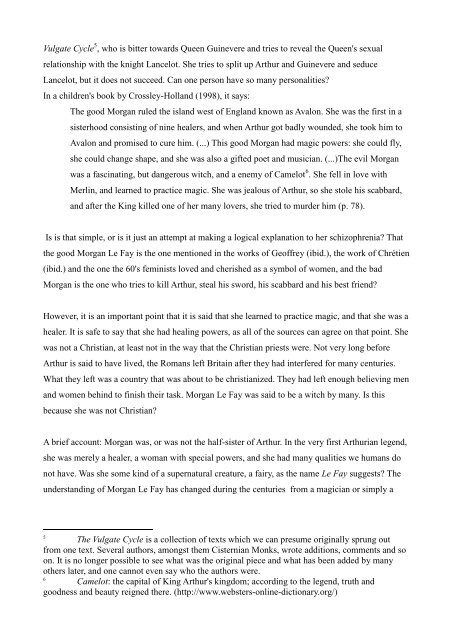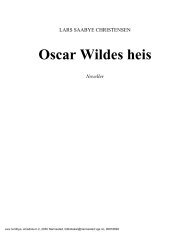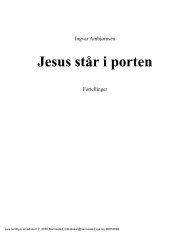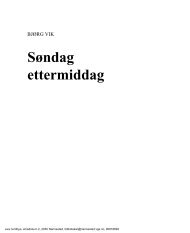Morgan Le Fay: Who was she? A paper written to enlight the woman ...
Morgan Le Fay: Who was she? A paper written to enlight the woman ...
Morgan Le Fay: Who was she? A paper written to enlight the woman ...
You also want an ePaper? Increase the reach of your titles
YUMPU automatically turns print PDFs into web optimized ePapers that Google loves.
Vulgate Cycle 5 , who is bitter <strong>to</strong>wards Queen Guinevere and tries <strong>to</strong> reveal <strong>the</strong> Queen's sexual<br />
relationship with <strong>the</strong> knight Lancelot. She tries <strong>to</strong> split up Arthur and Guinevere and seduce<br />
Lancelot, but it does not succeed. Can one person have so many personalities?<br />
In a children's book by Crossley-Holland (1998), it says:<br />
The good <strong>Morgan</strong> ruled <strong>the</strong> island west of England known as Avalon. She <strong>was</strong> <strong>the</strong> first in a<br />
sisterhood consisting of nine healers, and when Arthur got badly wounded, <strong>she</strong> <strong>to</strong>ok him <strong>to</strong><br />
Avalon and promised <strong>to</strong> cure him. (...) This good <strong>Morgan</strong> had magic powers: <strong>she</strong> could fly,<br />
<strong>she</strong> could change shape, and <strong>she</strong> <strong>was</strong> also a gifted poet and musician. (...)The evil <strong>Morgan</strong><br />
<strong>was</strong> a fascinating, but dangerous witch, and a enemy of Camelot 6 . She fell in love with<br />
Merlin, and learned <strong>to</strong> practice magic. She <strong>was</strong> jealous of Arthur, so <strong>she</strong> s<strong>to</strong>le his scabbard,<br />
and after <strong>the</strong> King killed one of her many lovers, <strong>she</strong> tried <strong>to</strong> murder him (p. 78).<br />
Is is that simple, or is it just an attempt at making a logical explanation <strong>to</strong> her schizophrenia? That<br />
<strong>the</strong> good <strong>Morgan</strong> <strong>Le</strong> <strong>Fay</strong> is <strong>the</strong> one mentioned in <strong>the</strong> works of Geoffrey (ibid.), <strong>the</strong> work of Chrétien<br />
(ibid.) and <strong>the</strong> one <strong>the</strong> 60's feminists loved and cheri<strong>she</strong>d as a symbol of women, and <strong>the</strong> bad<br />
<strong>Morgan</strong> is <strong>the</strong> one who tries <strong>to</strong> kill Arthur, steal his sword, his scabbard and his best friend?<br />
However, it is an important point that it is said that <strong>she</strong> learned <strong>to</strong> practice magic, and that <strong>she</strong> <strong>was</strong> a<br />
healer. It is safe <strong>to</strong> say that <strong>she</strong> had healing powers, as all of <strong>the</strong> sources can agree on that point. She<br />
<strong>was</strong> not a Christian, at least not in <strong>the</strong> way that <strong>the</strong> Christian priests were. Not very long before<br />
Arthur is said <strong>to</strong> have lived, <strong>the</strong> Romans left Britain after <strong>the</strong>y had interfered for many centuries.<br />
What <strong>the</strong>y left <strong>was</strong> a country that <strong>was</strong> about <strong>to</strong> be christianized. They had left enough believing men<br />
and women behind <strong>to</strong> finish <strong>the</strong>ir task. <strong>Morgan</strong> <strong>Le</strong> <strong>Fay</strong> <strong>was</strong> said <strong>to</strong> be a witch by many. Is this<br />
because <strong>she</strong> <strong>was</strong> not Christian?<br />
A brief account: <strong>Morgan</strong> <strong>was</strong>, or <strong>was</strong> not <strong>the</strong> half-sister of Arthur. In <strong>the</strong> very first Arthurian legend,<br />
<strong>she</strong> <strong>was</strong> merely a healer, a <strong>woman</strong> with special powers, and <strong>she</strong> had many qualities we humans do<br />
not have. Was <strong>she</strong> some kind of a supernatural creature, a fairy, as <strong>the</strong> name <strong>Le</strong> <strong>Fay</strong> suggests? The<br />
understanding of <strong>Morgan</strong> <strong>Le</strong> <strong>Fay</strong> has changed during <strong>the</strong> centuries from a magician or simply a<br />
5 The Vulgate Cycle is a collection of texts which we can presume originally sprung out<br />
from one text. Several authors, amongst <strong>the</strong>m Cisternian Monks, wrote additions, comments and so<br />
on. It is no longer possible <strong>to</strong> see what <strong>was</strong> <strong>the</strong> original piece and what has been added by many<br />
o<strong>the</strong>rs later, and one cannot even say who <strong>the</strong> authors were.<br />
6 Camelot: <strong>the</strong> capital of King Arthur's kingdom; according <strong>to</strong> <strong>the</strong> legend, truth and<br />
goodness and beauty reigned <strong>the</strong>re. (http://www.websters-online-dictionary.org/)






